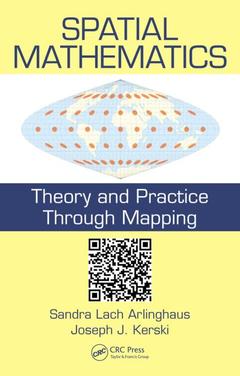Spatial Mathematics Theory and Practice through Mapping
Auteurs : Arlinghaus Sandra Lach, Kerski Joseph J.

In terms of statistics, GIS offers many connections. With GIS, data are gathered, displayed, summarized, examined, and interpreted to discover patterns. Spatial Mathematics: Theory and Practice through Mapping uses GIS as a platform to teach mathematical concepts and skills through visualization of numbers. It examines theory and practice from disparate academic disciplines such as geography, mathematics, physics, and general social science. This approach allows students to grapple with biodiversity, crime, natural hazards, climate, energy, water, and other relevant real-world issues of the twenty-first century.
Includes QR Codes Linked to Animated Maps, a Mapping Activity Site, or to an Interactive Webpage, Creating an Interactive Resource That Stays Relevant
The book integrates competing philosophical views of the world: synthesis and analysis. These two approaches yield different results and employ different tools. This book considers both approaches to looking at real-world issues that have mathematics as a critical, but often unseen, component. This approach shows readers how to use mathematics to consider the broad problem at hand and to explore diverse realms in the worlds of geography and mathematics and in their interface.
A truly interdisciplinary text, the book bridges the worlds of mathematics and geography and demonstrates how they are inextricably linked. It takes advantage of the convergence in citizen science, STEM education, and mapping that help readers become critical consumers of data?understanding its content, quality, limitations, and benefits. It provides thorough grounding in the analytical, statistical, and computational skills required for working in any field that uses geospatial technologies?not just surveyors and remote sensing analysts.
Geometry of the Sphere. Location, Trigonometry, and Measurement of the Sphere. Transformations: Analysis and Raster/Vector Formats. Replication of Results: Color and Number. Scale. Partitioning of Data: Classification and Analysis. Visualizing Hierarchies. Distribution of Data: Selected Concepts
Map Projections. Integrating Past, Present, and Future Approaches. Glossary. References, Further Reading, and Related Materials.
Sandra Lach Arlinghaus is an American educator who is Adjunct Professor in the School of Natural Resources and Environment at the University of Michigan.
Date de parution : 08-2013
15.6x23.4 cm
Date de parution : 12-2019
15.6x23.4 cm
Thèmes de Spatial Mathematics :
Mots-clés :
ArcGIS Online; QR Code; Esri Software; Mathematical Geography; Block Group; Data Set; Earth’s Polar Axis; Central Meridian; Standard Deviational Ellipse; Stereographic Projection; Dot Density Map; Dot Scatter; Euclidean Buffers; Blue Hexagons; UTM Northing; Pseudocylindrical Projections; Tornado Data; DD; Equal Area Projection; Color Ramps; UTM Easting; Red Hexagons; Equatorial Circumference; Great Circle Route; Dot Represents



